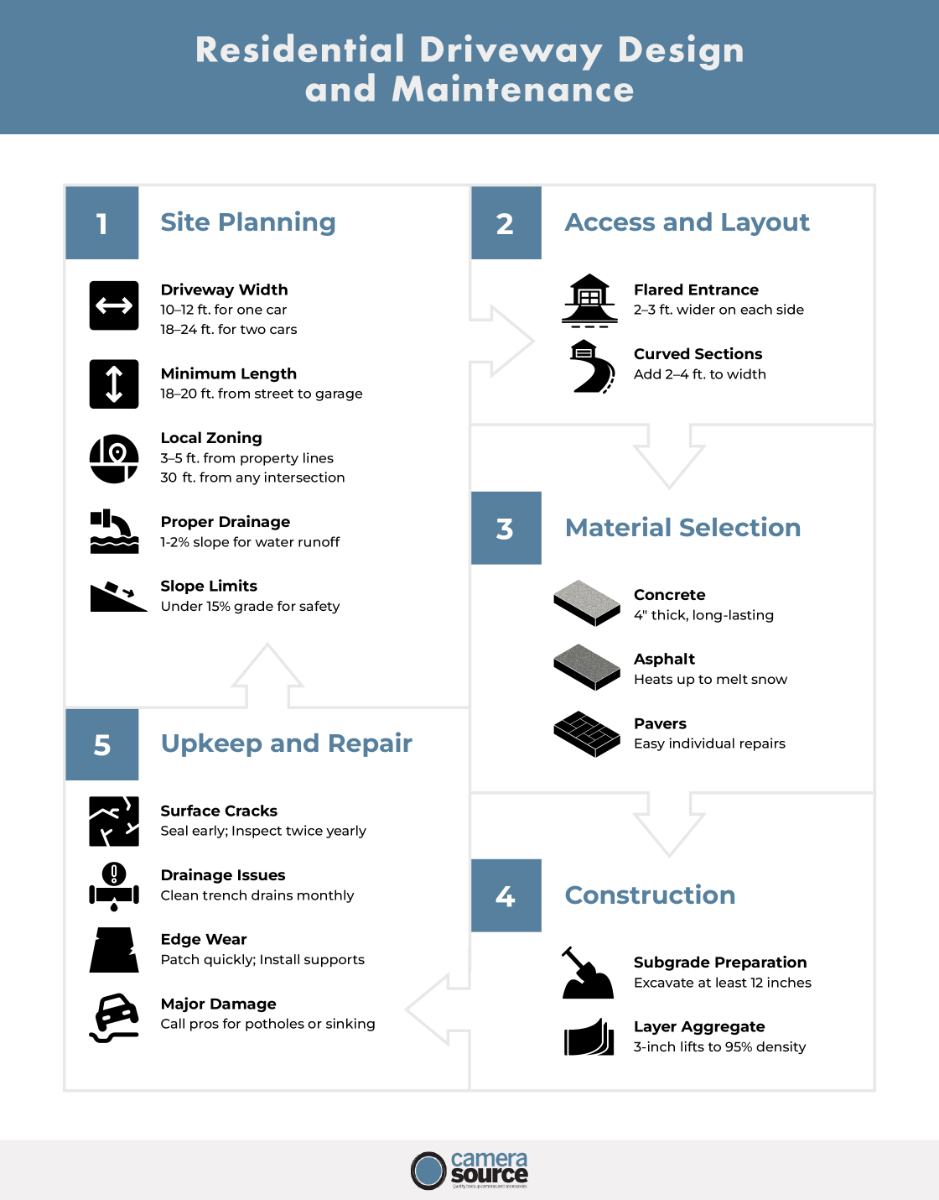A well-thought-out residential driveway does more than guide vehicles to the garage—it supports daily routines while complementing your home’s exterior. Residential driveway design guidelines outline specific standards, including lane widths of 10–12 feet and slope limits for proper drainage, all while integrating safety details and using materials that meet local building codes.
Key Takeaways
-
Smart layout and accurate measurements allow safer access while improving property usability.
-
Proper installation techniques and durable materials reduce the risk of future repairs.
-
Reliable drainage and thoughtful design details help protect both the driveway and everyone using it.

Planning Your Driveway
Getting the layout right starts with site evaluation, local code research, and understanding how the driveway will serve everyday movement on the property. If you're wondering how to design a residential driveway that balances function with curb appeal, this phase is where it all begins.
Initial Planning Tips
Start with a site survey. It’ll help determine the most visible and accessible location for the driveway entrance, ensuring drivers can see clearly when entering or leaving.
Keep width in mind: 10 to 12 feet works for one car, while two-car driveways should be 18 to 24 feet wide. These numbers help avoid awkward turns or tight spots.
Slope also matters—keeping grades below 15% maintains traction and prevents vehicle scraping. A subtle 2% cross-slope helps direct rainwater off the surface.
Here are key specs to factor in:
-
A minimum 15-foot turning radius
-
3–5 feet clearance from property lines
-
30 feet setback from any intersection
Wondering how to design a residential driveway to suit both city regulations and user needs? Start with proper width and slope, then plan for climate-appropriate materials. Match your surface choice to your environment. Concrete and asphalt handle different climates well, while gravel can be a cost-efficient pick for countryside lots.
Be proactive about drainage. French drains and catch basins are solid options to move water away from your house and driveway base.
-
Pro Tip: Sketch three layout options on graph paper. Compare accessibility, views, and sun exposure.
-
Watch Out For: Local codes—your county zoning office may mandate a 30-foot setback from intersections or a 3–5 ft property-line buffer.
Residential Driveway Design Guidelines: Driveway Dimensions And Layout
The effectiveness of any driveway depends heavily on getting the size and shape right—especially for safety and legal compliance. These residential driveway design guidelines make sure both functionality and compliance stay top of mind.
Driveway Sizing And Width
-
Single-car driveways need to be between 10–12 feet wide. Two-car setups benefit from a wider footprint of 20–24 feet.
-
Check local zoning ordinances—they often specify the minimum allowable width. It's a step you don’t want to skip.
-
Entrances benefit from being slightly wider. A flare of 2–3 feet on each side can ease turns and improve flow.
-
For curved layouts, increase the standard width by 2–4 feet near bends to help vehicles stay on track without oversteering. These layout choices follow residential driveway design guidelines to ensure comfortable navigation.
Driveway Length And Turnaround Areas
Proper driveway length and smart turnaround design are essential to ensure safe vehicle movement, prevent sidewalk encroachment, and maximize usability.
-
Minimum length: 18–20 feet from curb to garage face so cars don’t spill onto sidewalks.
-
Backing space: Allow 12 feet behind your car for safe reverse.
-
Turnaround styles:
-
T-Shape: Add a 10 × 20 foot “T” for quick pivots.
-
Circle: Carve out a 16–20 foot diameter for drive-through ease.
-
Hammerhead: Extend a 12 × 20 foot tongue behind a dead-end for three-point turns.
-
Pro Tip: On sloped sites, level the final 20 feet leading into your garage at no more than 7 percent, or you’ll scrape bumpers on the threshold.
Design Features And Materials
Visual appeal matters—but not at the expense of strength and safety. Residential driveway design guidelines recommend balancing performance with aesthetics. Every material and detail should serve both looks and longevity. Choosing the right materials is a big part of knowing how to design a residential driveway that holds up to weather, traffic, and wear.
Material Selection: Concrete, Asphalt, And Pavers
Concrete has staying power, typically lasting 25–30 years. For homes, 4 inches thick is the minimum. Reinforcement is smart in regions with cold winters.
Asphalt is budget-friendly and usable just a day or two after being laid. Its heat-absorbing qualities also help melt snow faster.
Pavers bring flexibility and design flair. These materials all satisfy various aspects of residential driveway design guidelines when installed correctly. Since they're individual units, damage is easy to repair without pulling up the whole surface.
Average installation costs:
-
Concrete: Lasts 25–30 years when you place 4 in. thickness in temperate climates, reinforced with wire mesh or fibers for freeze–thaw zones. Approximate installation cost is $8 per sq ft.
-
Asphalt: Dries in a day or two, absorbs heat to melt snow naturally. Budget: $3–7 per sq ft.
-
Pavers: Snap-in repairs, limitless patterns. Expect $10–20 per sq ft installed.
Incorporating Curves And Curbing
Curved driveways break up the visual monotony and make turning easier. Keep at least a minimum driveway turning radius of 15 feet for a comfortable arc.
Curbing keeps the borders clean and functional. Consider:
-
Minimum Radius: 15 ft for smooth arcs.
-
Curb Options:
-
Rolled curbs—gentle transitions
-
Barrier curbs—strong border
-
Mountable curbs—ideal when vertical clearance is tight
Pro Tip: Edge solar lights add safety and charm without raising your electric bill.
Construction Guidelines
Quality underground work makes or breaks your driveway’s lifespan. Don’t skip these steps recommended by top residential driveway design guidelines. Short-changing prep costs you a lot later.
Subgrade Preparation And Compaction
-
Excavate 12 inches deep: Remove topsoil, grass, and roots to prevent settling.
-
Test subsoil for clay content: If it holds water, dig deeper or stabilize with lime or geotextile.
-
Layer aggregate in 3-inch lifts: Compact each with a roller to at least 95 percent Proctor density. Skipping this “layer cake” invites future sinking and cracking.
-
Watch out for: Wet days ruin compaction efforts—schedule prep when you have a solid 48 hours of dry weather forecast.
Pavement Thickness And Aggregate Base
Stick to clean, crushed stone for the base. Local suppliers usually carry the right spec, such as #57 stone.
Concrete driveways:
-
6-8 inches of compacted #57 crushed stone base
-
4 inches concrete for cars; 6 inches for heavy loads
Asphalt driveways:
-
8-10 inches compacted stone base
-
Two-lift method: 2 inches hot mix base + 1 inch finish surface
Drainage And Grading Considerations
Water is your driveway’s worst enemy. Direct it away, or pay the price in potholes and erosion.
Effective Drainage Solutions
-
Minimum cross-slope: 1 percent (1 inch drop per 8 feet) to push water off the centerline.
-
French drains: Install alongside edges and tie into your yard’s storm system or a dry well.
-
Trench drains: Place at low points or transitions to intercept sheet flow.
-
Permeable pavers: Meet strict stormwater regs in runoff-sensitive zones—check your jurisdiction’s civil engineering standards.
Addressing Slope And Grading
-
Max driveway slope: 15 percent; aim for 10 percent or less for safety.
-
Crowned center: Raise the middle by ¼ inch per foot to split flow to both sides.
-
Transition zones: Ease from one grade to another over at least 10 feet to avoid scraping.
-
ADA requirement: Any cross slope on a pedestrian route (including driveway-sidewalk interactions) must not exceed 2 percent (1:48).
Safety And Accessibility
Driveway design impacts more than cars—it also affects visibility, comfort, and how easily everyone can move around the space. That’s why residential driveway design guidelines incorporate accessibility rules, slope requirements, and visibility checks.
Ensuring Safe Access And Sight Distance
-
Clear sightlines: Maintain 15 feet of unobstructed view in both directions at the entrance.
-
Motion-sensing LEDs: Mount on curb or bollards to flood the driveway when you approach—boosts safety without a constant power draw.
-
Flat entry pad: Keep the first 20 feet at no more than a 2 percent grade for easy maneuvering.
Compliance With Codes And Regulations
-
Width codes: 10 feet for single, 20 feet for two-way access—verify your town’s building code .pdf or online portal for specifics.
-
Sidewalk crossings: Any driveway crossing must maintain sidewalk cross slopes ≤ 2 percent for ADA (Accessible Route) compliance.
-
Permits: Check your local zoning board or municipal website; most cities require a driveway permit application that spells out setbacks, materials, and inspections.
Maintenance And Longevity
Even the best-built driveways need upkeep. Following residential driveway design guidelines includes maintaining materials and drainage systems. Treat your driveway to twice-yearly checkups and a bit of TLC—and it’ll reward you with decades of service.
Long-Term Maintenance Tips
-
Inspect in spring and fall: Look for hairline cracks; seal early to block moisture and freeze damage.
-
Sweep or blow off debris weekly: Leaves and grit accelerate wear.
-
Oil stain cleanup: Use kitty litter or commercial absorbents—skip rock salt in winter and use sand instead to preserve your surface and environment.
-
Reseal asphalt every 2–3 years: This helps fend off UV-driven oxidation.
Addressing Common Issues
Surface Cracks:
-
Seal tiny cracks right away.
-
Use patch filler for anything wider.
-
Watch fixed areas for signs of recurring stress.
Drainage Problems:
-
Check trenches and basins monthly.
-
Confirm slopes still channel water correctly.
-
Add or update drains when needed.
Edge Deterioration:
-
Install proper edge supports.
-
Patch broken sections quickly.
-
Monitor base support near corners.
If you spot potholes or major sinking, bring in a contractor. These can signal deeper problems you’ll want diagnosed fast.
Upgrade Driveway Safety with Advanced Vehicle Cameras
Why wait for a close call? Outfit your car with Camera Source’s Universal Mirror with Dash Cam and DVR for seamless front and rear recording, complete with a 4.3" display and built-in DVR. When paired with proper residential driveway design guidelines, this setup ensures safe navigation from garage to street, especially in tight or curved layouts.
Ready for full-coverage security? Make every drive safer with the perfect automotive backup camera for your vehicle.








